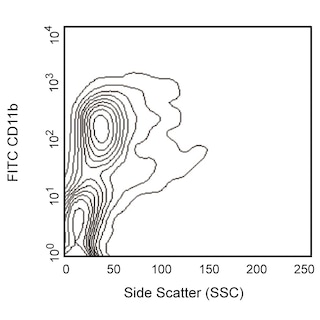Old Browser
Looks like you're visiting us from {countryName}.
Would you like to stay on the current country site or be switched to your country?


.png)

Expression of TLR4-MD-2 on peritoneal macrophages. Thioglycollate-elicited peritoneal macrophages from BALB/c mice were stained with either PE-conjugated rat IgG2a, κ isotype control mAb R35-95 (Cat. No. 553930, left panel) or PE-conjugated mAb MTS510 (right panel), in the presence of Mouse BD Fc Block™ purified anti-mouse CD16/CD32 mAb 2.4G2 (Cat. No. 553141/553142). The macrophages were identified by staining with FITC-conjugated anti-mouse CD11b (Integrin αM chain) mAb M1/70 (Cat. No. 557396/553310). The total viable leukocytes are displayed. Flow cytometry was performed on a BD FACSCalibur™ flow cytometry system.
.png)

BD Pharmingen™ PE Rat Anti-Mouse CD284/MD-2 Complex
.png)
Regulatory Status Legend
Any use of products other than the permitted use without the express written authorization of Becton, Dickinson and Company is strictly prohibited.
Preparation And Storage
Recommended Assay Procedures
Mouse BD Fc Block™ purified anti-mouse CD16/CD32 mAb 2.4G2 (Cat. No. 553141/553142) may help to reduce non-specific binding to cells bearing Fcγ receptors. If Mouse BD Fc Block™ is used, then it is important that the second-step anti-rat IgG antibody does not cross-react with the 2.4G2 mAb (Rat IgG2b, κ); we recommend the use of biotinylated anti-rat IgG2a mAb RG7/1.30 (Cat. No. 553894) with a "bright" third-step reagent, such as Streptavidin-PE (Cat. No. 554061).
Product Notices
- Since applications vary, each investigator should titrate the reagent to obtain optimal results.
- Please refer to www.bdbiosciences.com/us/s/resources for technical protocols.
- For fluorochrome spectra and suitable instrument settings, please refer to our Multicolor Flow Cytometry web page at www.bdbiosciences.com/colors.
- Caution: Sodium azide yields highly toxic hydrazoic acid under acidic conditions. Dilute azide compounds in running water before discarding to avoid accumulation of potentially explosive deposits in plumbing.
Companion Products

.png?imwidth=320)

.png?imwidth=320)

The MTS510 antibody reacts with the molecular complex of Toll-Like Receptor 4 and MD-2 (TLR4-MD-2) which is expressed on LPS responsive macrophages. TLR4, a member of the Toll-Like Receptor Family, has been renamed as CD284 and identified to be the transmembrane signal-transducing portion of the receptor for LPS. TLR4 associates on the cell surface with CD14 and MD-2, a 0.7 kDa molecule which is anchored to the membrane via its physical association with TLR4. The association of MD-2 with TLR4 is required for recognition of LPS and the anti-mitotic compound Taxol, which mimics the action of LPS on mouse cells. MTS510 mAb detects TLR4-MD-2 on the surface of thioglycollate-elicited macrophages from all mouse strains tested (ie, BALB/c, C57BL/6, C3H/HeJ, C3H/HeN, and DBA/1), including the C3H/HeJ strain which expresses an LPS-resistant mutant TLR4. Expression of TLR4-MD-2 is down-regulated on peritoneal macrophages after exposure to LPS, correlating with the occurrence of LPS tolerance. TLR4-MD-2 is not detected on splenocytes or thymocytes.

Development References (5)
-
Akashi S, Shimazu R, Ogata H, et al. Cutting edge: cell surface expression and lipopolysaccharide signaling via the toll-like receptor 4-MD-2 complex on mouse peritoneal macrophages. J Immunol. 2000; 164(7):3471-3475. (Immunogen). View Reference
-
Beutler B, Poltorak A. The sole gateway to endotoxin response: how LPS was identified as Tlr4, and its role in innate immunity. Drug Metab Dispos. 2001; 29(4):474-478. (Biology). View Reference
-
Kawasaki K, Nogawa H, Nishijima M. Identification of mouse MD-2 residues important for forming the cell surface TLR4-MD-2 complex recognized by anti-TLR4-MD-2 antibodies, and for conferring LPS and taxol responsiveness on mouse TLR4 by alanine-scanning mutagenesis. J Immunol. 2003; 170(1):413-420. (Biology). View Reference
-
Nomura F, Akashi S, Sakao Y, et al. Cutting edge: endotoxin tolerance in mouse peritoneal macrophages correlates with down-regulation of surface toll-like receptor 4 expression. J Immunol. 2000; 164(7):3476-3479. (Immunogen). View Reference
-
Shimazu R, Akashi S, Ogata H, et al. MD-2, a molecule that confers lipopolysaccharide responsiveness on Toll-like receptor 4. J Exp Med. 1999; 189(11):1777-1782. (Biology). View Reference
Please refer to Support Documents for Quality Certificates
Global - Refer to manufacturer's instructions for use and related User Manuals and Technical data sheets before using this products as described
Comparisons, where applicable, are made against older BD Technology, manual methods or are general performance claims. Comparisons are not made against non-BD technologies, unless otherwise noted.
For Research Use Only. Not for use in diagnostic or therapeutic procedures.
Refer to manufacturer's instructions for use and related User Manuals and Technical Data Sheets before using this product as described.
Comparisons, where applicable, are made against older BD technology, manual methods or are general performance claims. Comparisons are not made against non-BD technologies, unless otherwise noted.